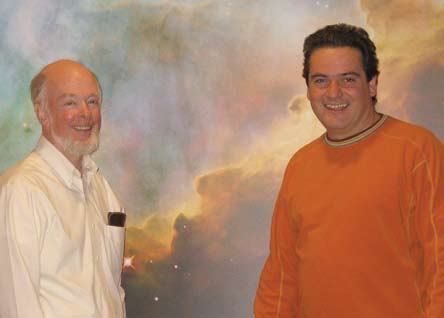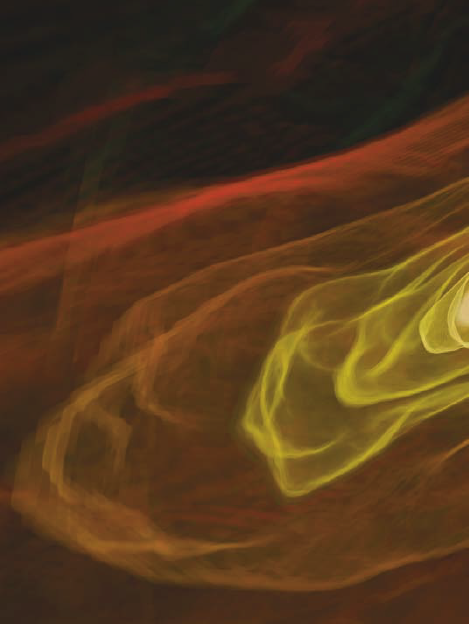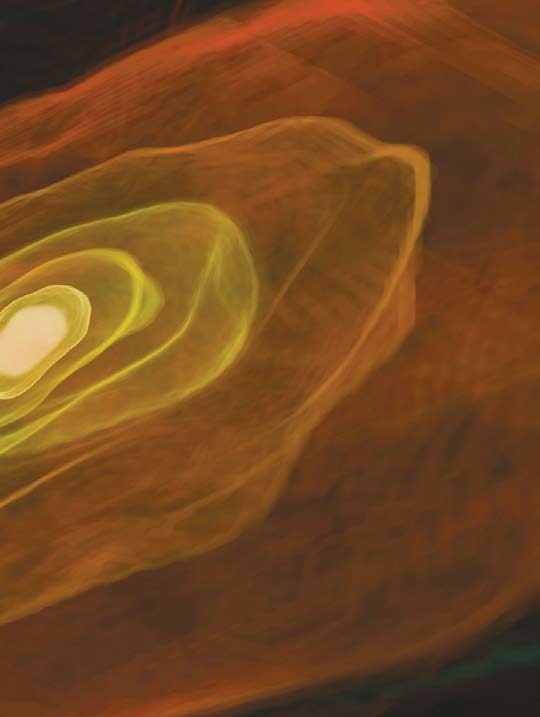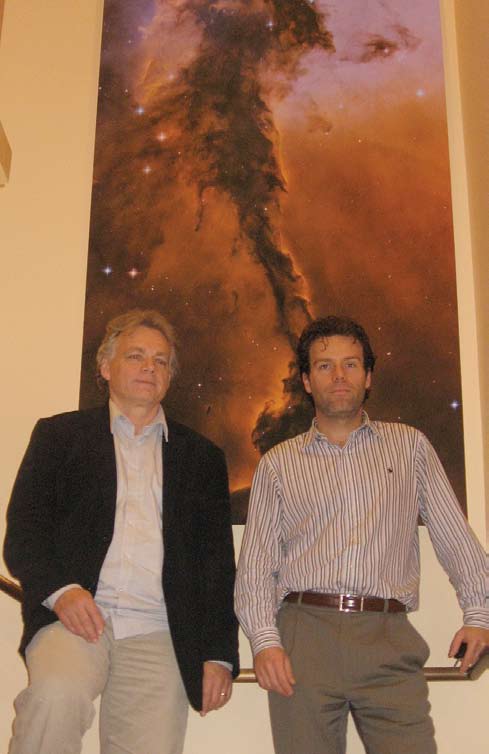Surprisingly, “the formation of the first stars is in some respects the best defined star formation mode,” according to the online prospectus for the program “Star Formation Through Cosmic Time” held Aug. 6 to Dec 7, 2007. What is surprising is the implication that a process that took place some 13 billion years ago (about 700 million years after the beginning Big Bang) should be better understood than the process in ensuing epochs of the universe, including our own right now. Why? Theorists think things were simpler back then.
What key scientific issues did the program address?
Said Chris McKee of Berkeley, one of four organizers, “What we wanted to try to do was to discuss all the aspects of star formation, starting with the very earliest stars and coming up to the present. There has been an enormous amount of progress recently in observing and understanding the formation and evolution of galaxies and the general structure of the universe. One of the parts of that whole picture which is most uncertain is actually how stars form. So we wanted to try to bring together experts from around the world to make some progress on that question.”
 Chris McKee (l) and Tom Abel. Photo by Charmien Carrier.
Chris McKee (l) and Tom Abel. Photo by Charmien Carrier.
Tom Abel of Stanford, another of the program’s coordinators, specializes in the first stars. He creates computer simulations to model the process whereby the very first stars — shining as much as a million times brighter than our sun — were formed. He likens those primordial objects to “rock stars” (e.g., Janis Joplin or Jim Morrison) — living fast, brilliantly flaming out, and dying young.
The more massive the star, the shorter its life, and the more likely it is to collapse in upon itself and expire in a supernova explosion. Since core collapse and supernova are the fate of stars eight times or more massive than the sun, those first stars — roughly 100 times more massive than the sun — were doomed to annihilate in titanic explosions that emitted the fused nuclei of elements (i.e., heavier than the stars’ initial constituent hydrogen), as well as enormous amounts of radiation.
Both the heavy elements and the radiation, in turn, altered the environment or medium and changed the process of star formation. For instance, seeding the medium with heavy elements enabled little stars to be formed. Their appearance represents something akin to a phase transition in the history of the universe. The smaller the star, the longer is its life; so some of the first small stars — those less than 0.8 solar mass — presumably still exist.
Since stars smaller than the sun are more numerous than stars more massive than the sun, how can observers tell the difference in age between two small stars?
Not Heavy Metal
The presumption is that the oldest small stars would be made from an interstellar medium with a dearth of metals. Observers today are looking for stars that have very small amounts of metals. They have to look in our own Milky Way galaxy, which is the only place where such small stars with “low-metallicity” would be close enough to earth to be detectable.
Observers have found some stars that have an amount of iron in them that is only 1/100,000 as much as the sun’s. Even though the amount of iron is dramatically low, the amount of the lighter element carbon is down only by a factor of 10; the relative amount of carbon is 10,000 times higher compared to the iron. So those stars provide interesting clues about the environment in early times after the first stars and therefore, retrospectively, about the processes within the first stars.
It may, in fact, be that low-metallicity stars reflect back not to the first, but to the second generation of stars forming in an ionized medium before the true advent of metals. The radiation emitted in the supernova death throes of the first stars would have ionized the medium, i.e., turning hydrogen atoms into hydrogen ions or plain protons, and thereby giving rise to a process or chemistry for star formation different from the very first process.
Looking for those stars with low metallicity — living fossils, so to speak — is akin to doing stellar archaeology. They provide, according to McKee, “a very important observational window on star formation.” What it would take to open that window wider is the proposed, very large 30-meter telescope. The partnership to build the estimated $750-million instrument includes the University of California, the California Institute of Technology, and Canada, and is being spearheaded by UCSB Chancellor Henry Yang.
The most common type of star is slightly smaller than the sun, which is itself half through its 10-billion-year lifespan.
Late in life, stars less than eight times as massive as the sun expand into “red giants” (larger [hence “giants”] but cooler [hence “red”]), and then the outer envelope puffs away leaving a little more than half the original mass. What is left is a white dwarf, and what is puffed out contains a dust of heavy elements that, in turn, also alters the environment for star formation.
So the processes, whereby stars form, change across cosmic time because the stuff out of which they form changes.
The Importance of Dust
For instance, dust is important because atoms stick to it. It has some sort of surface that neutral hydrogen atoms can move around on. Two hydrogen atoms moving on dust are more likely to find each other than if the dust grain weren’t there. When the two neutral hydrogen atoms come together, they make a hydrogen molecule, and the binding energy of the molecule usually lifts them off the dust grain. Hence, dust particles are important contributors in turning gas clouds into the molecular form of hydrogen.
Stars form in clouds of molecular hydrogen. The clouds are cold and dark.
But the first stars formed before there was dust. So the first epoch of star formation differed significantly from star formation in successive epochs. All the gases for star formation early on were warmer in part because no dust absorbed radiation, and the typical speeds for interactions were therefore faster, so massive stars of pure hydrogen grew fast. Since it takes lower temperatures to make low mass stars, there weren’t any early on.
“If something is warm,” said Abel, “it has more pressure; and so it will try to resist gravity much more than something cold unless, of course, the something that is warm is more massive, so that it experiences a gravitational force strong enough to counter the thermal pressure. That is why there could only have been larger stars early on."
“Our simulations predict only big ones early on. They can’t make small ones. Those findings are consistent with observations.” Conversely, it gets harder and harder to make big, big stars as the universe evolves.
Though Abel speaks with conviction about the first stars, there is a contrarian’s view (as with most aspects of the various star formation scenarios across cosmic time). Understanding that view, even briefly, requires an introduction to the dark matter, which the standard view of early star formation sees as creating the “potential well” that enabled the first star formation.
Down the Dark Matter Well
Dark matter is called “dark” because it does not radiate, but interacts with baryonic or ordinary matter (made up of protons and neutrons) gravitationally. What exactly dark matter is, no one knows, though the best guess is that it is comprised of the lightest supersymmetric particles whose existence is postulated by a particle-physics theory called “Supersymmetry.” By far, most of the matter in the universe is dark.
As McKee explains, “The first stars formed in a well that was created by dark matter, and as the baryons accumulated, eventually they acquired a high enough density that they would become self-gravitating, and they would collapse on their own. The difference between the baryons and the dark matter is that the baryons can lose energy [radiate]. When two baryons collide, they lose energy by radiation. As far as we know, dark matter colliding doesn’t lose energy; so the baryons can condense to much higher densities than the dark matter.”
What did change over time was the role of dark matter in star formation. “Though the very first stars formed in the gravitational potential well of this dark matter,” said McKee, “right now when stars form, all the baryons are gathering together, and the dark matter has nothing to do with it.” When the sun formed five billion years ago, the dark matter played no role.
McKee estimates that 99 percent of experts on star formation affirm that the first stars were massive.
A contrary but creative view (by Katherine Freese of the University of Michigan and her student Douglas Spolyar of the University of California at Santa Cruz and their collaborator Paolo Gondolo of the University of Utah) paints a picture of the lightest sypersymmetric particles and their anti-particles bashing into one another, annihilating, and turning into hugely energetic gamma rays and electrons and positrons. All that energy in turn would halt the fledgling first star’s contraction. In place of the massive first star that Abel’s simulations envision appears a curious object with a radius 10 times that of the sun (about the distance from earth to sun) though only a little more massive. The stuff of this star would be so diffuse that instead of running on normal, stellar nuclear reactions, it would be powered by dark matter annihilation.
Despite such an intriguing alternative hypothesis, there is consensus among most program participants about the construction of the first stars. But two big open questions that engendered lively debates among the 116 “Star Formation” program participants are:
 Genesis simulated. Credit: Tom Abel
Genesis simulated. Credit: Tom Abel
 Genesis simulated. Credit: Tom Abel
Genesis simulated. Credit: Tom Abel
1. How rapidly do stars form?
2. What explains the distribution of the mass of the stars that form?
McKee and one of his former students, Mark Krumholz of Princeton, have put forth one point of view on the rate of star formation. Another of the program organizers, Paolo Padoan of the University of California at San Diego, has done new simulations that could confirm that theoretical model, and perhaps extend it to include the effect of magnetic fields. McKee, who finds Padoan’s results “interesting,” said, “We would like to understand the rate of star formation quantitatively and not just qualitatively, which is the kind of understanding that people had before.”
What is so intriguing about the mass distribution of stars is how fixed it appears to be across cosmic time despite the differences in star formation processes across time. (The sun is a little bit more massive than average.) “We are looking for general principles that predict this distribution and give probabilities,” said McKee.
“If,” he explained, “the spectrum of the stellar mass is dependent on the details of the physical condition, then you’d think you would find completely different distributions of mass in different places, but you don’t. If you look at globular clusters [the most ancient stars found in globs spherically distributed in the Milky Way], these very, very old stars generally exhibit a peak in their mass spectrum that is similar to the peak inside the disk [the extended plane of the galaxy where gas and dust are densest and where star formation is ongoing]. The physical conditions when a globular cluster formed would probably have been very different than the physical conditions in star formation today, and yet somehow the typical mass is the same!” exclaims the usually quiet-spoken McKee.
Why? The answer likely has to do with the overriding and most important topic of the “Star Formation” program — turbulence or chaotic motion in the gas.
Is Turbulence the Key?
 Paolo Padoan (r) and his long-time collaborator Aake Nordlund. Photo by Charmien Carrier.
Paolo Padoan (r) and his long-time collaborator Aake Nordlund. Photo by Charmien Carrier.
Said McKee, “The issue that has been a constant source of discussion is turbulence, both in the interstellar medium and in the molecular clouds. What is the source of this turbulence that is everywhere observed? We really don’t have a very good understanding.”
Turbulence may be the key to star formation. Most of the astrophysicists attending the program think so though some, such as Frank Shu of San Diego, disagree. Like the other much discussed phenomenon of magnetism, turbulence is thought both to inhibit and to enhance star formation.
Most importantly, turbulence, because it is universal, may provide a natural way of explaining a universal pattern such as the mass distribution of stars across cosmic time. Such an explanation would mean, of course, that regularities pertain with respect to chaotic motion.
“We decided,” said Padoan, “to do idealized computer experiments with the single purpose of understanding the physics of supersonic turbulence, both with and without magnetic fields. And that’s what we did for almost 10 years. In fact, we add gravity in the code, but kept it off. (It’s been hard to resist the temptation of turning gravity on because when you turn on gravity, you form stars.)"
“We discovered universal statistical properties of turbulence,” he said. “The beauty of turbulence is that it’s very complex, but it’s got some kind of self-organization, or else there wouldn’t be this mass spectrum of stars. There is a pattern, universal and scale-free. We think we have learned the probability distribution of the density field and the scaling of velocity in turbulence, and then we use those statistics to model analytically the mass distribution of stars. Soon we will have a theory of star formation, which is in a sense analytical, but whose ingredients — the fundamental results of supersonic turbulence — could not have been achieved without numerical simulations.”
Looking ahead, Padoan said, “In order to convince the community, especially at this point, requires a world-record simulation. It’s going to have to be a realistic simulation of a star-forming region, not just an idealized numerical experiment.” Then comes the next step, “We — and others — have to try to disprove the theory, which is very important!” he said.
The Third Way
McKee calls computer simulations the third way of doing physics. The other two are theory/analytic technique and experiment.
Numerical simulations seem like a kind of telescope that brings cosmic events far, far away in time and space to focus in mind. Talking star formation with both simulators, Padoan and Abel, is quite an experience because they seem to be describing vast cosmic events that they are actually seeing occur in their minds’ eye.
Padoan seems to peer deep inside dark molecular clouds of hydrogen to discern sheets, formed in rebound from shocks, in turn intersecting and forming filaments that then intersect and form the core where the proto-star gestates.
Abel conjures up the first stars turning on like fireworks going off in the darkness that “was upon the face of the deep” and gives new meaning to the old divine injunction, “Let there be light.”
